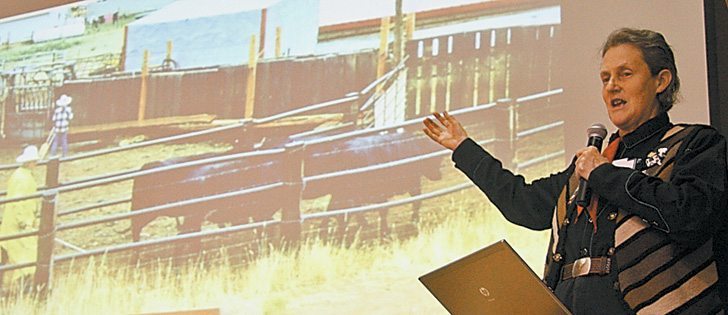Cattle producers may dream big after hearing Temple Grandin talk about proper animal handling, but they have to be careful not to slip back into old ways.
Grandin, arguably the world’s most famous animal behaviour specialist, spoke to a standing room only crowd Jan. 19 as keynote speaker at the Lethbridge College Tiffin Conference.
“You’ve got to maintain handling. A lot of people go out and go to a seminar and they’re all gung ho, ‘we’re going to do really good cattle handling,’ and you come back a year later and they’ve slowly slipped back into bad practices,” she said.
Read Also

Using artificial intelligence in agriculture starts with the right data
Good data is critical as the agriculture sector increasingly adopts new AI technology to drive efficiency, sustainability and trust across all levels of the value chain.
Grandin, a professor at Colorado State University, was last year named in Time magazine’s list of 100 most influential people. She has autism and has often said the condition helped her understand how animals feel and behave.
She has designed livestock handling systems and packing plant facilities aimed at lowering animal stress. She is widely sought as a consultant on animal behaviour, writes widely on the subject and has written two books about humane livestock handling and animal behaviour.
Grandin told her Lethbridge audience that simple things can reduce livestock stress in handling. Moving cattle calmly, without shouting, waving or using electric prods, are important parts of that, she said.
“People working with animals need to learn how to be observant,” she said in an interview before her talk.
“They tend to be afraid of little things we don’t notice. A chain hanging down in a chute, reflection on a chute, a piece of metal jiggling, a coat on a fence.”
Producers should take advantage of cattle’s tendency to follow one another and to go back the way they came. Curved chutes, sight lines and avoidance of overcrowding can ease stress on animals and people.
“Less bruises, better safety for people, you’re going to be less likely to get dark cutting meat or tough meat, better weight gain, less sickness. There’s lots of reasons for handling animals quietly and it’s one of the things that doesn’t cost anything to implement.”
Grandin is an advocate of video auditing in packing plants and was instrumental in getting some major packers to use it.
Cargill and JBS Swift both have cameras in their plants, including the Cargill plant in High River, Alta., she said.
“Auditors back in the United States can watch in at any time and see what’s going on in the stunning chute, the unloading area and the cattle handling area, and the advantage of doing that auditing over the internet is you get rid of the problem of people acting good when they see a person there with a clipboard.”
It has been 35 years since Grandin started working to improve livestock handling, and she said there has been progress.
“Compared to the bad old days in the ’80s and ’70s, there has been a lot of improvement, and what I’ve seen is, the people I’d classify as excellent and good, that has really increased.
“Unfortunately there’s still a bottom 10 percent that are still just as bad as they were back in the ’70s, but more and more people are getting aware of good handling.”
More information on livestock handling is available on Grandin’s website at www.grandin.com.
















